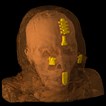Finer Detail Of 2000 Year Old Mummy Revealed By 3D Holography Imaging

Pioneering 3D visualisation holographic imagery is being used to reveal the concealed detail of an Egyptian mummy unseen for more than two millennia
Egyptian Mummies shrouded for over 2000 years could be set to give up their inner secrets like never before. Thanks to a 3D hologram imaging process developed by Edinburgh-based Holoxica, the Rhind Mummy has been revealed in true 3D.
Originally excavated from a tomb in Thebes (Luxor) almost 155 years ago, the Rhind Mummy – so named after the renowned Scottish Archaeologist and Egyptologist Alexander Rhind who brought the mummy to Scotland in the middle of the 19th Century – is completely intact in its original black-tarred linen wrapping. The mummy has been in the National Museum of Scotland’s collection ever since.
Until recently, no one knew what was contained inside the shroud, but a series of CT scans at Edinburgh Royal Infirmary carried out by the University of Edinburgh’s Clinical Research Imaging Centre (CRIC) showed the revelations were nothing sort of startling – the CT scans revealed the mummy was an Egyptian female aged 25-29, 5ft 2 ins tall, dating back to around 10BC.
She was revealed to hold a papyrus scroll in her right hand, the so-called Book of Breathing, with instructions to help her on the journey into the afterlife. The cause of death is still unknown, although medical experts believe it could be an infection followed by untreatable pneumonia.
The team at the Clinical Research Imaging Centre, believed they could retrieve more intricate detail on the Rhind Mummy and called in Edinburgh-based 3D holographic imaging specialist Holoxica to assess the feasibility of making a 3D hologram to depict the mummy more accurately as Javid Khan, managing director of Holoxica explains.
“We collaborated with Dr Martin Connell a visualisation engineer at CRIC and Dr Elena Kranioti a forensic anthropologist at the University of Edinburgh’s School of History and Archaeology. We began by painstakingly piecing together an animated hologram of the Mummy’s head and upper shoulders which reveals different layers of visual information as the viewer of the hologram moves from left to right.
“For example, the first layer is the wrapping shroud, which ‘peels’ away to reveal her face. This is followed by the skull. The ‘outer wrapping’ is encrusted with jewels and gold amulets which are visible from angles and, most intriguingly, a metal scarab-shaped cap was placed on top of the skull during mummification, can also be seen in great detail.
“This mummy will never be opened and will always remain intact, so the only way to look inside is to use state of the art scanning and visualisation techniques. The colour animated hologram is the best way to depict this artefact, which is life-sized and shows a level of depth, detail and realism that is difficult to demonstrate in any other way.”
The hologram of the Rhind Mummy has been submitted to the Massachusetts Institute of Technology for ISDH 2012 - the forthcoming 9th International Symposium on Display Holography being held in June, before being put on display thereafter at the MIT Holography Exhibition from June this year running through to September 2013.
For more information, visit www.acumen-pr.com.
SOURCE: Holoxica
